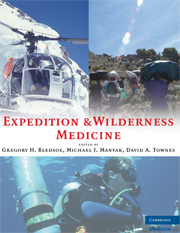Book contents
- Frontmatter
- Contents
- Contributors
- Foreword
- Preface
- Acknowledgments
- PART I EXPEDITION PLANNING
- PART II EXPEDITIONS IN UNIQUE ENVIRONMENTS
- PART III ILLNESS AND INJURIES ON EXPEDITIONS
- 24 General Medical
- 25 The Diarrhea of Travelers
- 26 Malaria: Diagnosis, Prevention, and Treatment for the Traveler
- 27 Wild Animal Attacks and Injuries
- 28 Snake and Arthropod Envenoming
- 29 Hazardous Marine Life
- 30 Expedition Toxicology
- 31 Environmental Injuries
- 32 Penetrating and Explosive Wounds
- 33 Drowning and Submersion Injury
- 34 Evaluation and Acute Resuscitation of the Trauma Patient
- 35 Principles and Practice of Expedition Wound Management
- 36 Expedition Eye Injuries and Disorders
- 37 Dental Medicine on Expedition
- 38 Foot Injuries
- 39 Expedition Orthopedics
- 40 Expedition Self-Rescue and Evacuation
- 41 Aeromedical Evacuations
- APPENDIX The Expedition Medical Kit
- Index
26 - Malaria: Diagnosis, Prevention, and Treatment for the Traveler
from PART III - ILLNESS AND INJURIES ON EXPEDITIONS
Published online by Cambridge University Press: 05 March 2013
- Frontmatter
- Contents
- Contributors
- Foreword
- Preface
- Acknowledgments
- PART I EXPEDITION PLANNING
- PART II EXPEDITIONS IN UNIQUE ENVIRONMENTS
- PART III ILLNESS AND INJURIES ON EXPEDITIONS
- 24 General Medical
- 25 The Diarrhea of Travelers
- 26 Malaria: Diagnosis, Prevention, and Treatment for the Traveler
- 27 Wild Animal Attacks and Injuries
- 28 Snake and Arthropod Envenoming
- 29 Hazardous Marine Life
- 30 Expedition Toxicology
- 31 Environmental Injuries
- 32 Penetrating and Explosive Wounds
- 33 Drowning and Submersion Injury
- 34 Evaluation and Acute Resuscitation of the Trauma Patient
- 35 Principles and Practice of Expedition Wound Management
- 36 Expedition Eye Injuries and Disorders
- 37 Dental Medicine on Expedition
- 38 Foot Injuries
- 39 Expedition Orthopedics
- 40 Expedition Self-Rescue and Evacuation
- 41 Aeromedical Evacuations
- APPENDIX The Expedition Medical Kit
- Index
Summary
Disclaimer: The views herein are solely those of the author and are not to be construed as official or representing those of the U.S. Army or the Department of Defense.
INTRODUCTION
Throughout the ages, explorers, adventurers, soldiers, and travelers have met a determined foe. The human disease caused by the malaria parasite, the most important parasitic disease of mankind, has extracted a devastating toll on the serious explorer as well as the vacationing traveler resulting not only in failed missions, curtailed voyages and expeditions, but ultimately in death. Nevertheless, the devastating effects of malaria can be countered through diligent preparation before embarking on an adventure. Currently, the World Health Organization (WHO) estimates that over 100 countries frequented by 125 million travelers each year are endemic for malaria (Figure 26.1), resulting in thousands of cases of imported malaria to the United States, Europe, and Australia. It is expected that the number of cases of imported malaria will increase due to the rapid spread of drug-resistance, an increase in transmission due to climactic changes and global warming in areas previously at low risk for malaria, and an increase in international travel, adventure voyages, and expeditions. According to WHO estimates, between 350 million and 500 million cases of acute clinical malaria occur each year worldwide with greater than one million deaths primarily in children in sub-Saharan Africa. The exact number is unknown due to vast underreporting and incorrectly diagnosed cases. This chapter will summarize the critical and practical steps that health care providers and travelers alike can apply to prevent and minimize the devastating consequences of this disease if encountered on one's journey.
- Type
- Chapter
- Information
- Expedition and Wilderness Medicine , pp. 361 - 372Publisher: Cambridge University PressPrint publication year: 2008

